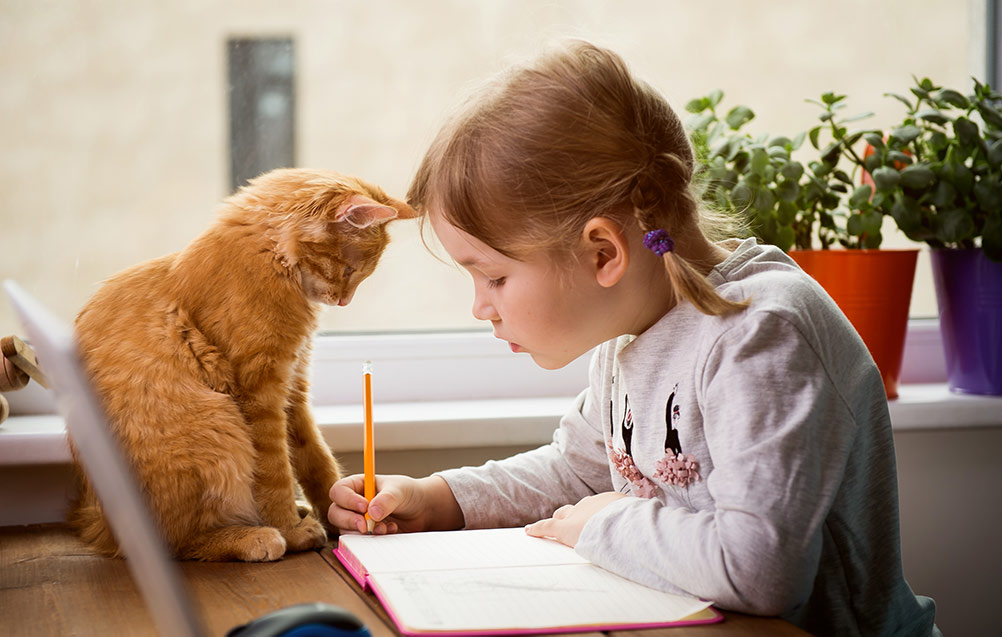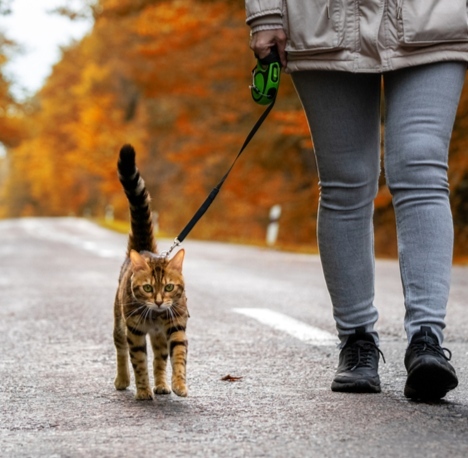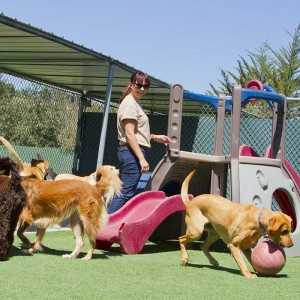Travelling with cats: Tips for travelling with a cat in a car
Almost a third of all Australian households own a cat, and while most of us regard our pets as treasured companions and family members, on the whole we keep our felines entirely at home. Despite this tendency, it’s gradually becoming more popular to take our cats out of the house with us, whether for walks or hikes on leash, or away for a weekend trip or longer holiday.
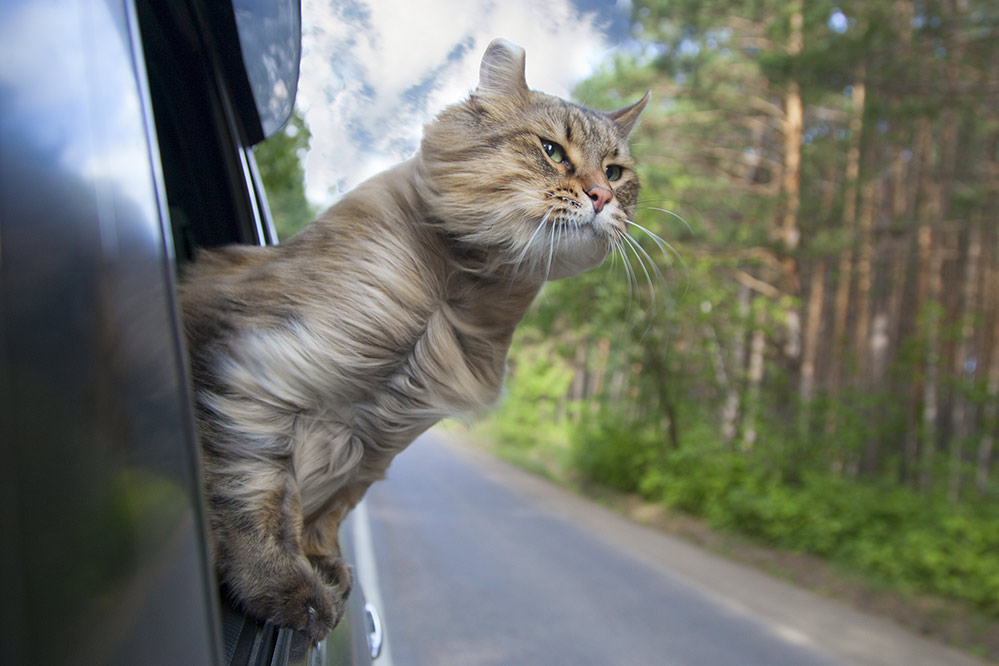
How to NOT travel with your cat
One problem that may hold back many cat owners from travelling with cats is that these adventures require car trips. Unfortunately, the thought of a long drive with a cat in the car fills many cat parents with trepidation, for several reasons. Many cats do not travel well; they tend to get stressed and to suffer from motion sickness. Many cats are indeed fearful of car travel, having formed negative associations of carriers and car trips with visits to the vet. And adult cats typically like routine, they like the safety of their home, and they don’t like change.
The good news is that If cats are properly adapted and conditioned to riding in a car, they can learn to tolerate it, and with luck even enjoy it. Unsurprisingly, the best time to teach cats to travel comfortably is when they are still a kitten, and if your cat is young and/or has not had a negative experience in the car, adaptation can be quick and easy. The process of learning to travel in the car is essentially the same for all ages, but for older cats and those with unpleasant associations from prior trips, it will most likely take considerably more time, effort and patience. Read on to discover our practical tips and advice on what to do, what to bring and what to be prepared for when undertaking the challenge of travelling with cats.
Choosing a cat carrier
Cats should travel in a carrier or crate that is belted in, strapped down or otherwise secured in the backseat. Most importantly, never leave your cat loose in the car while travelling; while it’s perfectly legal to drive with pets in Australia, you are not allowed to drive in a way that threatens their safety. The laws differ from state to state, but one consistent rule is that it’s illegal to drive with a pet on your lap, and if your cat is unrestrained, she may well decide to hop onto yours.

Source: https://www.necoichi.com/Products/detail/id=3702
It’s far safer for your cat (and for you) when she’s contained in a crate. A pet running loose in the car can easily distract the driver, interfere with the ability to steer or brake, or become a projectile in the event of a crash or sudden stop, plus she could easily escape as soon as any of the car doors or windows are opened. Being buckled in with a harness is not recommended for cats as it’s just not safe enough – cats can wriggle out of them with ease. Letting her ride in the front seat is also a no-no because airbags can cause terrible damage to her if you’re in an accident. Penalties apply, so as well as the issue of safety, containing your pet will avoid possible fines or demerit points.
There is a vast array of carrier options available in different sizes and materials and with hard or soft sides. So, how do you choose the best one for your cat? The biggest or most expensive is not necessarily the most suitable. Bear in mind that for long distance travel she’ll need to remain in the carrier for lengthy periods, so make sure you pick one that’s strong, secure, easy to clean (in case of accidents) and the correct size for your cat.
Top tips
- An opening at the top makes it easier and less stressful when getting your cat in and out.
- Look for one with a built-in way to secure the carrier in your vehicle.
- If you want one that can double as your cat’s bed while you’re traveling, consider a smaller, cosier carrier.
- If you have space limitations at your destination, consider an airline-type plastic carrier that can be disassembled.
- Wire, mesh or other carriers that allows your cat to see out of all sides can be covered with a blanket or cloth for a more comforting and cosier feel.
- Cardboard boxes are not a good option as they will get flimsy and fall apart if the cat urinates in it.
- Consider the size carefully: although it may seem logical to get the biggest carrier available, some cats prefer to feel snug and a larger carrier can make them feel insecure, while a carrier that’s too small for your cat will cause her to feel cramped.
- Large carriers and crates can accommodate a litter tray and food and water bowls, but will obviously occupy more space in the car, so weigh up these options carefully.
If you plan to travel with more than one cat, you could put them in one large carrier, but particularly for longer trips, a separate carrier for each is probably a good idea. Even if they are bonded friends, there is a chance that they may become stressed with the travel and act out towards each other, escalating stress and possibly causing injury. You can position their carriers to face one another in the rear seat so they can clearly see each other but keep a sheet or towel handy in case you feel the need to visually separate them.
Getting your cat to love (or tolerate) road trips
Travelling successfully with a cat ideally begins long before the day of travel. Particularly if your cat has already exhibited an aversion to travel or to her carrier, you should begin your preparations a few weeks or even months prior to your travel date. Repeating the steps outlined below each day will help prepare your cat for travel so that it is a pleasant experience for both of you. Note that since each cat and each situation is different, it could take anywhere from a few days to several months for an individual cat to successfully adapt to car travel.
Step 1: Get your cat to know the carrier
Start by introducing your cat to the carrier while at home. Your aim is to get her to see it as a familiar, comfortable and safe space in which to hang out. Try these top tips to create positive associations with the carrier:
- Leave the carrier open on the floor and available for her to explore at any time.
- Make it comfortable with soft and cosy bedding.
- Make it appealing with a favourite toy and/or a familiar scent such as an item of your clothing.
- Feed her treats, play with her and pet or groom her while she is close to it or inside it.
- Try to feed her some of her meals in the carrier.
- Encourage her to jump in and explore it by tossing treats inside it.
- Practice entry and exit from the carrier to make it as routine a process as possible.
- Once she is comfortable to be inside it, carry her around the house and outdoor areas the carrier.
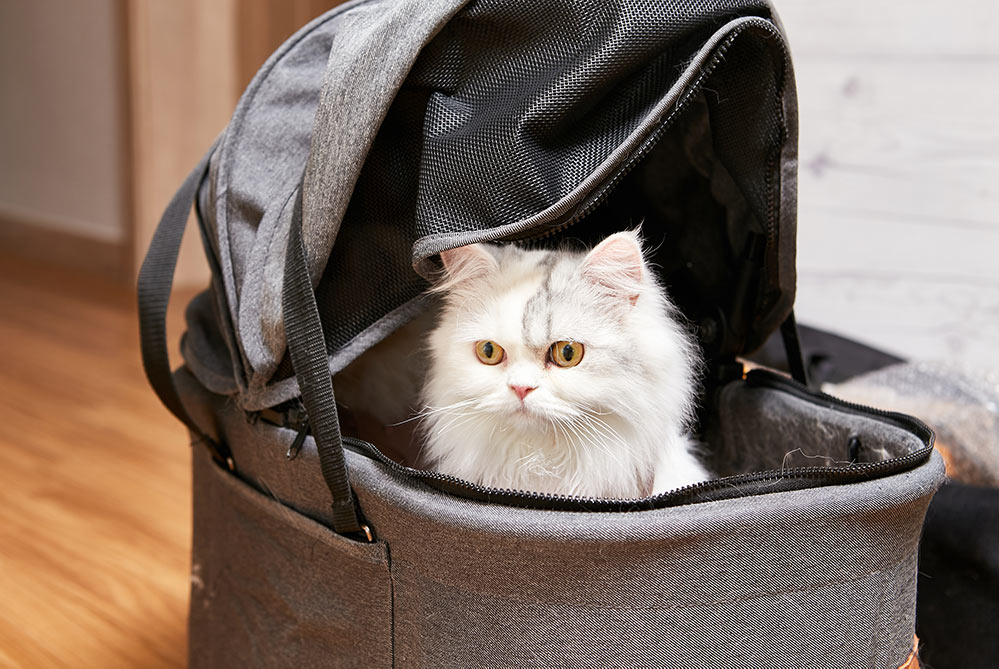
Step 2: Get your cat to know the car
The next step is to gradually get your cat accustomed to the car. Once she is comfortable being carried around in the carrier, take her to the vehicle. With the car parked and the doors and windows closed, sit on the back seat with her in her carrier next to you. Partially open one of the carrier doors to get your hand in to play with your cat, pet her, praise her, and give her treats.
Once she is comfortable and unafraid in the stationary car, buckle the carrier to the back seat, scatter some of her favourite food in the carrier with her and then start the engine. Sit next to her to observe how she acts with the sound and vibration of the engine running. Then take her back into the house in her carrier. Repeat this over a few days, also observing how she reacts when you turn on the air-conditioner, heater, or radio. Be sure to comfort, soothe and treat her if she gets stressed by any of these sounds.
Once she is relaxed in the above scenarios, take her on short drives for a few days, at first just around the block or up the street, and then gradually increasing the distance as she becomes more comfortable and realises that nothing bad is going to happen. She may be a bit vocal at first but will usually settle down once you’re on your way. When you get back home, take her into the house, out of her carrier, and reward her with a treat and/or some time playing or snuggling with her.
Top tips
- Never push these drives further than your cat is comfortable with.
- Drive calmly and go easy on the accelerator and brakes.
- This process is best done with two people – one to drive the car, the other to sit in the back to observe, pet, praise and treat the cat (if necessary, it can be done with one person, too, but very slowly and carefully).
- If she is struggling to relax in the car, consider using a calming spray like Feliway (only spray the carrier, not your cat), putting some catnip in the carrier, or try playing some soothing music.
Road trips with your cat
Before you go…
Be sure your cat has an up-to-date identification tag on her collar during your travels and have her microchipped before you depart if you haven’t already done so (and if you have, make sure her details are up to date). You can also consider making a temporary ID tag with the address and phone number at your final destination. While travelling, she should wear a well-fitted harness from which she cannot escape. It’s also wise to fit her with a tracker or a GPS device that can monitor her whereabouts, in case she does find a way to escape.
Make sure your cat is protected from fleas and other parasite infestation before heading out on the road. While certain parasites might be rare where you live, they may be prevalent in the area you’re traveling to, so do some research before you go. If you are travelling to areas where ticks are very common, we recommend consulting your vet before you leave.
Items to pack for your trip
Cats tend not to like change. Space may be limited in your car, but it’s essential to pack everything your cat will need for the entire trip or until you can source local supplies of her familiar brands of food, treats and litter.
Top tips
- It’s highly recommended to take her regular food rather taking a chance with an unfamiliar brand at your destination; a new diet is likely to unsettle her further and may even cause a tummy upset.
- Consider packaging her meals in individual portions for ease of feeding.
- Take her own familiar food and water dishes (but only if they are unbreakable).
- Consider packing some large bottles of water from home – water in a different part of the country may have a different taste that is not to your cat’s liking. It may also have a different mineral content that may cause an upset stomach.
- Take some familiar items from home to help her settle in, such as a scratching post, favourite toys and cosy, familiar bedding.
- Pack your cat’s medical documents including vaccination certificates, recent lab-work, her rabies vaccination tag, as well as any medications she takes.
- Take a litter tray, litter, a litter scoop and bags for litter disposal (see “Litter trays and toileting stops” below).
- Buy or assemble a pet first aid kit (ask your vet what it should include, as this can be influence by your cat’s breed, age and medical history.)
On the road
When the big day arrives, place the cat carrier on top of a waterproof sheet on the back seat in case of accidents. If the weather is warm, position it on the side of the car that is likely to be shadier, and if cold, on the sunnier side. Make sure it’s securely fastened and will stay in position if you need to brake suddenly.
Adjust the heating or cooling to make sure your cat is neither too hot nor too cold. Once she is secure in her carrier you can open the car window a little for some fresh air. Be aware though, that driving noises can be sometimes quite loud and stressful to some cats. Make sure that all the windows and doors are closed before opening the carrier at any time during the journey to prevent any escape attempts.
Make sure you never leave your cat alone in the car on a hot day, even for a few minutes. Stationary cars can heat up very quickly, even on relatively mild days, and it really isn’t worth putting her at risk. If you need a bathroom or food stop and are travelling alone, rather take her with you in the carrier than leave her alone in the car.
Litter trays and toileting stops
A good travel litter tray will be large enough for your cat to fit in comfortably to do her ablutions, yet small enough to fit in her carrier or on the floor of the car. Fortunately, most cats can manage to use the litter tray without having to leave the vehicle. Plan to stop every couple of hours at a designated rest area to let her out of the carrier – with all the car doors and windows securely closed – so she can have a walk around inside the car and use the litter tray. Then simply dispose of the mess in a garbage bag or rubbish bin and be on with the trip.
Top tips
- Choose a good travel litter tray that is waterproof, easy to clean and collapsible (for easy storage), yet sturdy (so it won’t collapse while your cat is using it).
- Another option is to purchase some disposable litter trays that come with litter already inside.
- Pack extra litter and liners so you can dispose of these in a rubbish bin after each use.
- Use a litter that she already likes and is used to using.
- You can also use a litter attractant to encourage her to use the tray.
- Whichever option you choose, get your cat used to using this set-up well before you start your trip.
- If your cat appears to be moving around more or is being more vocal in the carrier, take it as a signal that a rest/toilet break is needed.
- Line the carrier with an absorbent “puppy potty pad” in case your cat needs to urinate or defecate during travel.
- In case of accidents, pack some extra blankets and pads as well as a couple of garbage bags, some paper towels, and a few disposable gloves for any clean up required.
If your cat is used to doing her ablutions outside, you really don’t want the smell of cat litter and toileting in your car, or there’s just no room for a litter tray, then, depending on the length of your car trip, you may need to schedule outdoor toilet stops for your cat. This is most safely achieved if you’ve taken the time to leash train your cat well in advance of your travels.
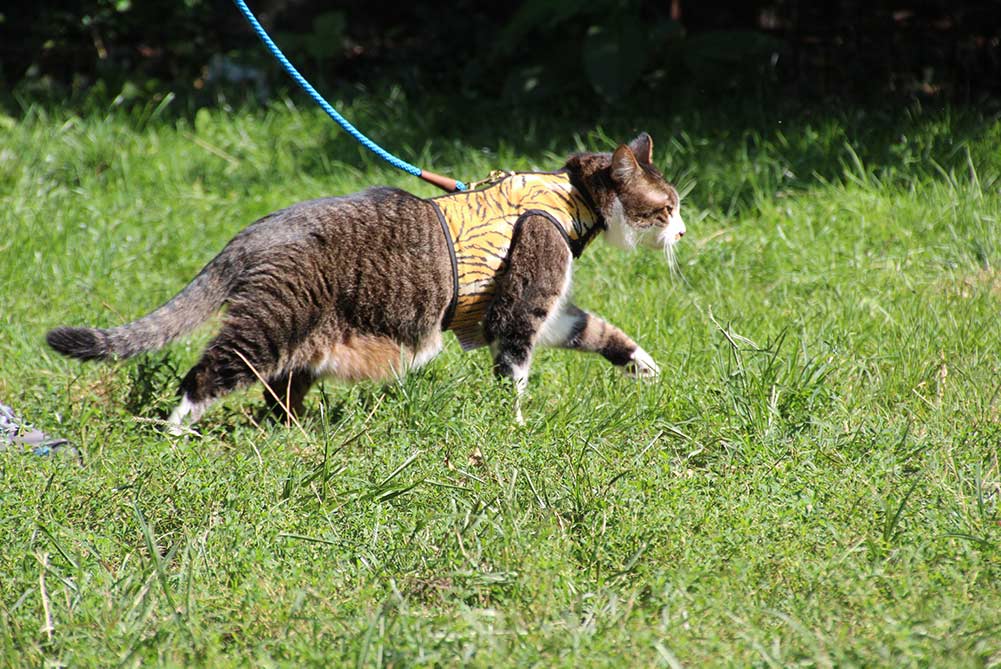
See Walking with cats: Tips for leash walking, hiking and camping with your cat for more information on leash training.
Whether using the indoor or outdoor option, you should plan to stop every 1 to 2 hours if necessary, until your cat has toileted, after which it’s safe to wait another 4 hours before stopping. It may take a few stops before she’s comfortable enough to use the tray whilst on the road, but at least giving her the opportunity will hopefully prevent any accidents or discomfort for her. If she still doesn’t use it on her own and she allows it, you could try placing her directly onto the tray.
Eating and drinking on the road
Don’t feed your cat within an hour or two before you depart on your trip, nor while you are driving if you can help it. Cats tend to suffer from motion sickness, so travelling on an empty stomach will minimize the risk of your cat vomiting in her carrier during the trip. Feed her a small meal when you arrive at your evening destination; she will be just fine only eating in the evening for a day or two.
Be sure to bring plenty of water in the car with you, but only offer it to your cat at any rest stops and/or toilet stops you make during the trip. Do not leave a water bowl in the carrier while driving – it will most likely spill and you will end up with a wet and miserable cat.
Top tips
- Cats won’t always drink water that tastes different, so if you have the space for it, bring bottles of water that your cat drinks at home, whether it is tap water or filtered water.
- To prevent spillage in the car or carrier, use a plastic container with a lid and cut a small hole in the lid that’s just big enough for you cat to fit her snout in.
Stressed or carsick cats
Many cats suffer from motion sickness and/or anxiety issues that can contribute to travel difficulties. If you know your cat is a particularly nervous or sickly traveller, speak to your vet well in advance of your departure – they may suggest medication to help her relax or to prevent carsickness and vomiting.
Top tips for coping with difficult feline travellers
(be sure to test these out, as well as any prescription medication, well in advance of travel)
- Raise the carrier to the height of the window so that the cat can look outside – this can help with motion sickness.
- Schedule additional or longer breaks at rest stops to let your carsick cat out of the car into the fresh air, either in her carrier or on the leash if she’s trained to use it.
- Calming treats can be used both before and during travel.
- Anti-anxiety jackets are compressive and comforting to some cats.
- A few drops of a pheromone spray on the towel or mat in the carrier can reduce stress.
- Catnip or catnip spray sprinkles in their carrier helps some cats.
- Calming music might help some cats.
- Pet wipes or baby wipes are indispensable for cleaning up all kinds of messes.
Cats with chronic health issues
It’s a good idea to consult with your vet about your cat’s suitability for a long journey, as every cat is different and there may be issues that you haven’t thought of. Consider your cat’s general health and any previous anxiety during confinement. If your cat has been unhappy about travelling in the past, you might want to weigh up whether taking them along is the best option.
If you decide to go ahead, ensure your cat has a check-up with your vet. You’ll have more peace-of-mind knowing that their condition is being well managed and that they are as healthy as possible before heading off. Your vet will also have advice for making your cat as comfortable and safe as possible on the trip. Be sure to obtain a copy of your cat’s medical records to take with you, including names and dosages of any medications and supplements they are taking. This will make visiting another vet much easier, if the need arises.
Top tips
- If your cat is on a special prescription diet, find out if you’ll be able to purchase it at your destination or make sure you take enough supplies with you for the duration (plus extra, in case of unforeseen delays).
- Stock up on your pet’s medications and supplements, as well as any medical supplies you need for her (plus extra, in case of unforeseen delays).
- If your cat is diabetic and on insulin, you will need a cooler box and ice packs to help keep it cool while in the car (or you can purchase a cooler that plugs into your car’s cigarette lighter).
Holidays and weekends away with your cat
Finding cat-friendly accommodation
Once your cat is travel-ready, the next challenge is finding a suitable place to stay with her. In many locations it can be difficult to find cat-friendly accommodation, so as soon as you know your travel dates, try to book your accommodation. This is especially important in the busy summer travel season and around school holidays.
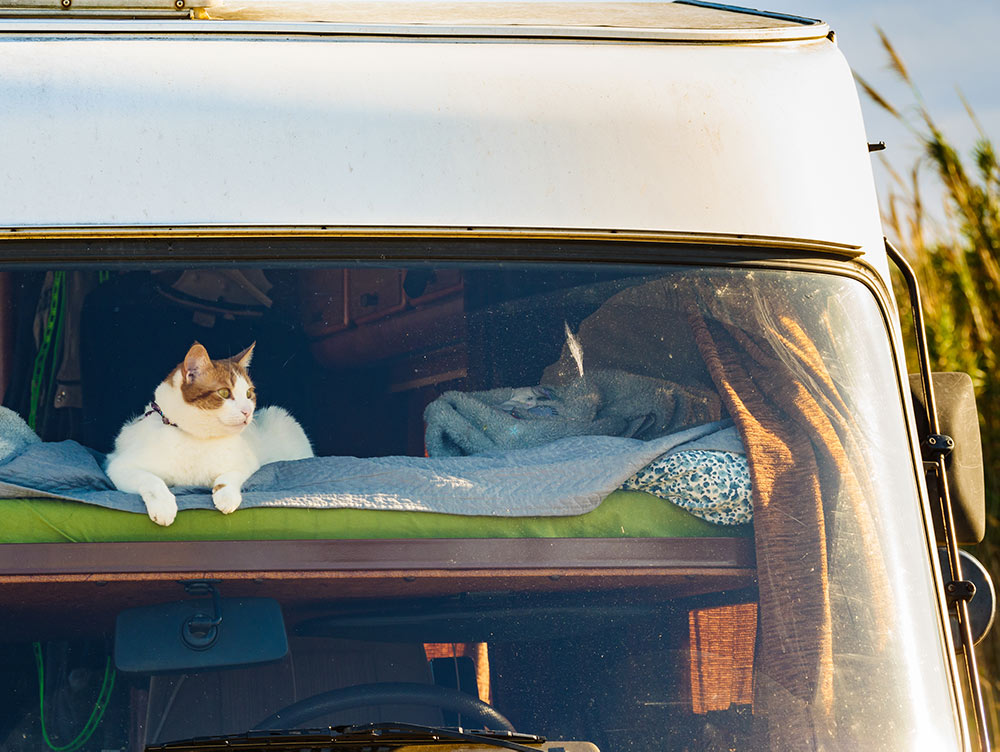
Not all hotels and motels welcome pets, and even those that do may only have a few pet-friendly rooms. Be aware that “pet-friendly” often just means “dog-friendly”; sadly, plenty of pet-friendly places are not actually cat-friendly. You may need to widen your search to include caravan parks, B&B’s and private holiday homes. Most of the popular booking sites allow you to search for pet-friendly properties, so make sure that you tick the “pets allowed” box in the search filters to find these.
Always double-check directly with the property owner or manager that cats are specifically welcome before making any payments – some may only accept pets that are housed outdoors. In unfamiliar places, cats should stay indoors, unless they are supervised and on a leash outside (toileting included). Also, ask about the presence of other animals on the property.
If you’re happy to splurge, a growing number of luxury hotels are catering for cashed-up owners and their pampered pets, offering comfy beds, spa treatments and gourmet food for both 2-legged and 4- legged guests. While many of these “pooch packages” are geared to dogs, Brisbane’s trendy W hotel caters for cats too, even providing litter trays and litter. In Sydney, The Langham in the historic Rocks also provides 5-star accommodation for feline fur babies and a pet-friendly menu. And, while pets cannot be left alone in the room, pet sitting services are usually available. Be sure to verify each hotel’s specific pet policies and check the fine print before making your reservation.
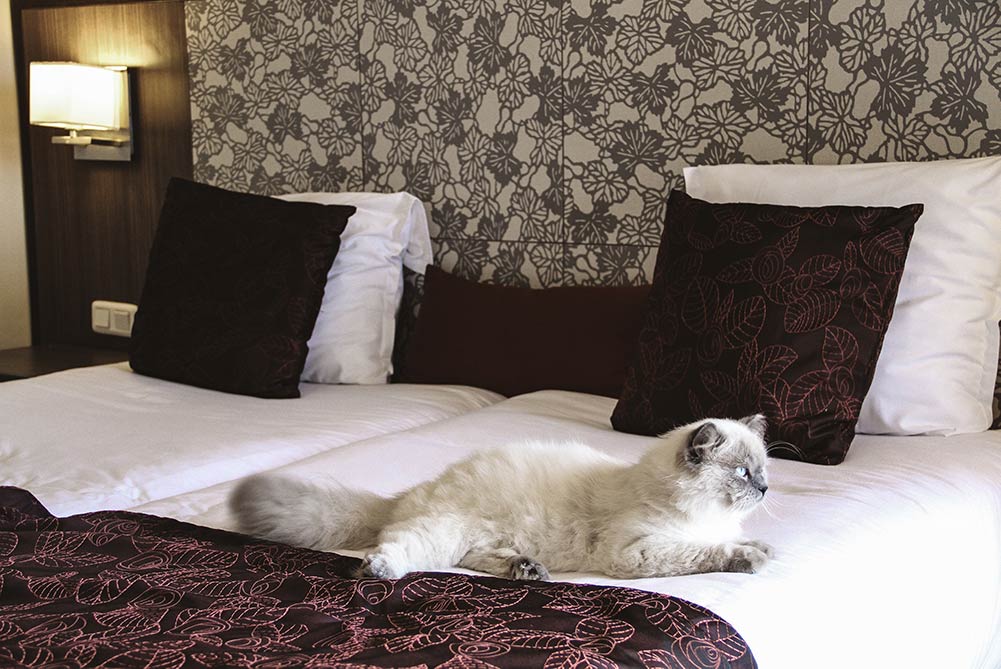
Arriving at your holiday accommodation
The first thing on your to-do list once you arrive at your accommodation is to check for hazards and to make sure that all doors and windows are secure. Even if your cat is already familiar with the outdoor environment at your destination or there’s a securely fenced outside area, we do not recommend leaving her unleased outside, as this could be really dangerous; plus, cats are so quick to escape…
We recommend that you confine your cat to one secluded room while she settles into her new environment. Leave her in her carrier in a quiet place while you unpack, then secure the room and allow her out of the carrier to explore at her own place. Place her familiar bedding and bowls filled with her usual food in the room with her, as well as some favourite toys and perhaps some boxes to hide in. Your cat should stay in this room for as long as it takes her to calm down, which can range from a couple of hours to a few days. When she is settled, accompany her while she explores the remainder of the accommodation at her own pace, making sure that any “no-go” areas are sealed off.
Top tips
- Know where to find a nearby vet in case of a medical emergency.
- Make sure your cat is always wearing a collar and identification tag in case she gets out.
- Don’t leave her alone in the accommodation – if you book an activity that doesn’t allow you to bring her along, you’ll need to find a pet sitter or kitty day-care.
- Don’t leave her alone in the car on a hot (or warm) day – if you need to run into the shops or do other errands, go in the evening when it’s cooler or have someone stay in the car with her.
Find pet friendly accommodation in Australia

